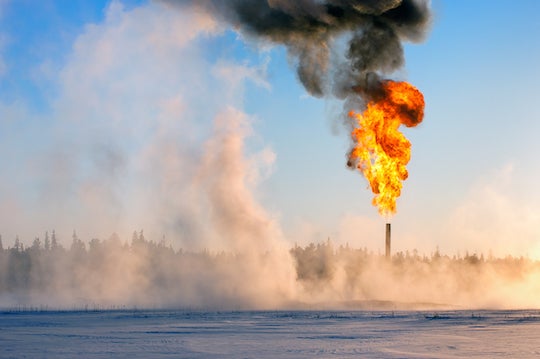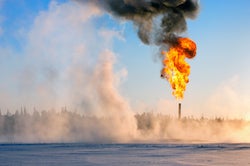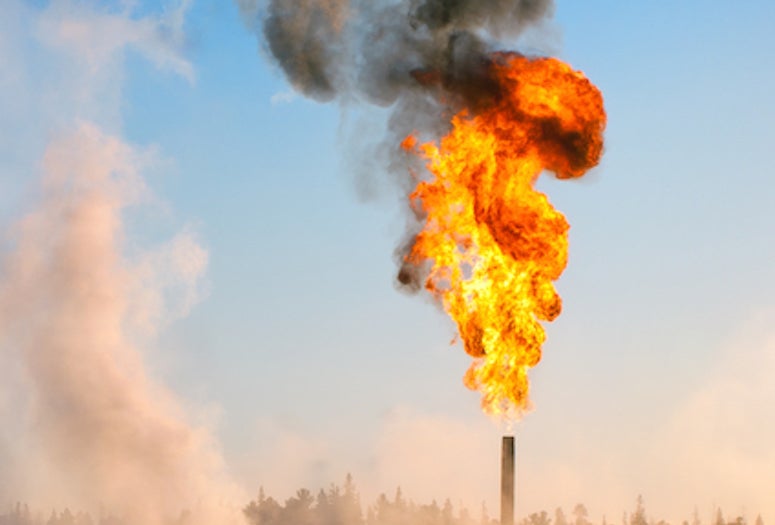HOUSTON – (Feb. 25, 2022) – Newly published research by Rice University environmental engineers suggests flaring of natural gas from oil and gas fields in the United States, primarily in North Dakota and Texas, contributed to dozens of premature deaths in 2019.
Satellite observations and computer models can link gas flares to air pollution and health, according to Daniel Cohan of Rice’s George R. Brown School of Engineering and his colleagues, who published their findings in the journal Atmosphere.

Oil and gas producers flare excess gas when infrastructure to bring it to market is unavailable. While flaring reduces the direct venting of the powerful greenhouse gas methane into the atmosphere, it also produces black carbon particles, also known as soot or particulate matter. These particles, smaller than 2.5 microns in diameter, can impair lung function and cause respiratory disease, heart disease and strokes.
The Rice team partnered with researchers from the Clean Air Task Force to produce calculations, based on infrared satellite observations of oil fields where 97% of flaring takes place, showing that the United States emitted nearly 16,000 tons of black carbon in 2019. The researchers used computationally efficient reduced-form models to estimate that 26-53 premature deaths were directly attributable to air quality associated with flares.
“Our research shows that flaring not only wastes a valuable fuel but is deadly, too,” said Cohan, an associate professor of civil and environmental engineering, who led the study with first-year graduate student Chen Chen. “Particulate matter causes more deaths than all other air pollutants combined, and flares are an important source of it.”
Flares aren’t the only source of particulate matter in the atmosphere. Particles are also produced whenever fossil fuels are burned, including by vehicles, and by wildfires, cooking meat and other sources.
The researchers’ models accounted for the fact that the heat content of the burning fuel varies widely across oil and gas fields and has a strong impact on black carbon emissions.


“For this study, we used 10 different emission factors for flares, and using the reduced-form models made the calculations super-fast,” Chen said. “Other studies show a good relationship between full and reduced-form models, so we’re confident in our results.”
Cohan said black carbon emissions also contribute to climate change by absorbing solar radiation in the atmosphere, influencing the formation of clouds and accelerating snow and ice melt, though all of those consequences were beyond the scope of their study.
The researchers noted there are cost-effective technological alternatives to flaring, including gas-gathering pipelines, small-scale gas utilization and reinjecting excess back into the ground. While the Environmental Protection Agency (EPA) is considering regulations to reduce both methane emissions and associated gas flaring, there are currently no federal limits to the widespread practice of flaring, they wrote.
“We initially didn’t think about publishing a peer-reviewed paper,” Chen said. “We were asked by the Clean Air Task Force to estimate these health impacts to support their advocacy to reduce harmful pollution from oil and gas production. But because the study clearly shows dozens of deaths per year due to flaring, we thought a paper would provide regulators with new angles to consider in their efforts to minimize the impacts of oil and gas air pollution.”
Co-authors are senior scientist David McCabe and senior analyst Lesley Fleischman of the Clean Air Task Force.
Image for download:

https://news-network.rice.edu/news/files/2022/02/0228_FLARES-1-WEB.jpg
Rice University engineers show that flaring of natural gas at drilling sites in the United States, primarily in North Dakota and Texas, contributed to dozens of premature deaths in 2019. (Credit: 123rf)
Located on a 300-acre forested campus in Houston, Rice University is consistently ranked among the nation’s top 20 universities by U.S. News & World Report. Rice has highly respected schools of Architecture, Business, Continuing Studies, Engineering, Humanities, Music, Natural Sciences and Social Sciences and is home to the Baker Institute for Public Policy. With 4,052 undergraduates and 3,484 graduate students, Rice’s undergraduate student-to-faculty ratio is just under 6-to-1. Its residential college system builds close-knit communities and lifelong friendships, just one reason why Rice is ranked No. 1 for lots of race/class interaction and No. 1 for quality of life by the Princeton Review. Rice is also rated as a best value among private universities by Kiplinger’s Personal Finance.

